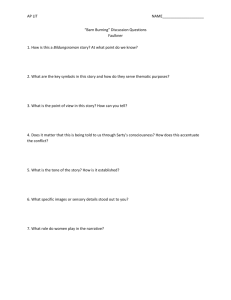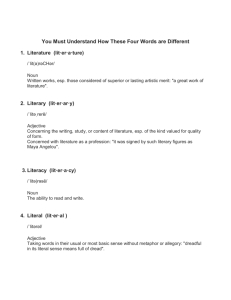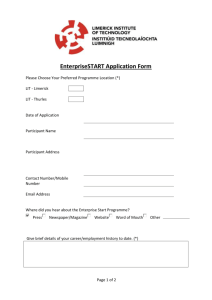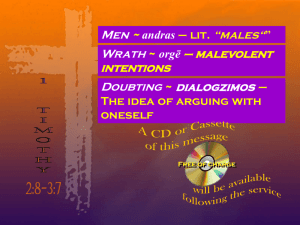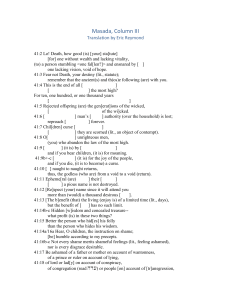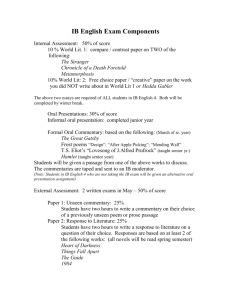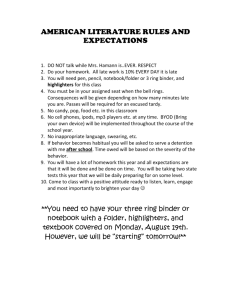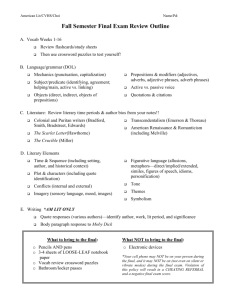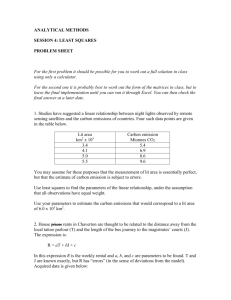American Literary Periods: Overview & Characteristics
advertisement
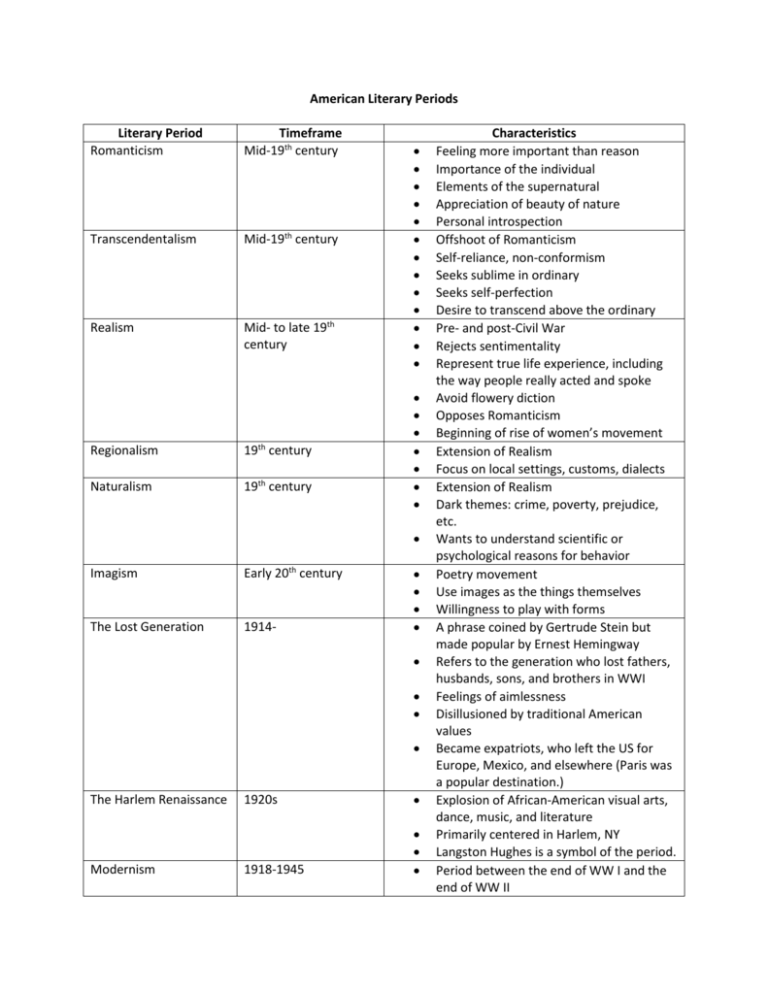
American Literary Periods Literary Period Romanticism Timeframe Mid-19th century Transcendentalism Mid-19th century Realism Mid- to late 19th century Regionalism 19th century Naturalism 19th century Imagism Early 20th century The Lost Generation 1914- The Harlem Renaissance Modernism 1920s 1918-1945 Characteristics Feeling more important than reason Importance of the individual Elements of the supernatural Appreciation of beauty of nature Personal introspection Offshoot of Romanticism Self-reliance, non-conformism Seeks sublime in ordinary Seeks self-perfection Desire to transcend above the ordinary Pre- and post-Civil War Rejects sentimentality Represent true life experience, including the way people really acted and spoke Avoid flowery diction Opposes Romanticism Beginning of rise of women’s movement Extension of Realism Focus on local settings, customs, dialects Extension of Realism Dark themes: crime, poverty, prejudice, etc. Wants to understand scientific or psychological reasons for behavior Poetry movement Use images as the things themselves Willingness to play with forms A phrase coined by Gertrude Stein but made popular by Ernest Hemingway Refers to the generation who lost fathers, husbands, sons, and brothers in WWI Feelings of aimlessness Disillusioned by traditional American values Became expatriots, who left the US for Europe, Mexico, and elsewhere (Paris was a popular destination.) Explosion of African-American visual arts, dance, music, and literature Primarily centered in Harlem, NY Langston Hughes is a symbol of the period. Period between the end of WW I and the end of WW II Post Modernism 1945- The Beat Movement 1950s Gonzo Journalism 1970- Magical Realism 1960s Creative Nonfiction Late 20th and early 21st centuries Themes: Alienation and the loss of the individual to the machine. Influential historical context – Industrial Revolution, mass immigration to US, women’s rights, Great Depression Begins with use of atomic bomb to end WW II Themes: alienation due to race, gender, etc.; intolerance; political and social oppression Post-apocalyptic themes Satire The absurd Anti-heroes Rise of multiculturalism and diversity Leaders were poet Allen Ginsberg and novelist Jack Kerouac Rejected mainstream American values Embraced nonconformity and Eastern philosophy Forefather of the 1960s counter-culture movement (Hippie Movement) Any new kind of journalism where the writer can be part of the story, blending fact and fiction Magical and supernatural elements appear in otherwise realistic settings Began in painting Mostly associated with Latin American writers Blends elements of literature with nonfiction Includes memoir, travel and place essays, personal narratives, etc. Literary Timeline Timeframe 800 – 400 BC 250 BC – 150 AD 450 – 1066 1066 – 1500 Prominent Authors WORLD LIT: Greeks – Homer (The Iliad and Odyssey), Sophocles (Oedipus Rex and Antigone), Euripedes (Medea) WORLD LIT: Romans – Vergil (The Aenid), Horace (poet and satirist), Ovid (lyrical poet) WORLD LIT: Haiku poetry in Japan BRITISH LIT: Anglo-Saxon Period – Beowulf WORLD LIT: Italian writers – Petrarch (sonnets), Dante Alighieri (The 1500 – 1650: The Renaissance 1660 – 1785: The Neoclassical Period 1750 – 1800: The Age of Reason / Revolutionary Literature 1785 – 1830: The Romantic Period / Romanticism 1832 – 1901: The Victorian Period Divine Comedy – Paradiso, Inferno, Purgatorio), Boccaccio (The Decameron) BRITISH LIT: Middle English Period – Geoffrey Chaucer (The Canterbury Tales) Historical Note: German Johannes Gutenberg invents the printing press. WORLD LIT: Spanish writer – Miguel de Cervantes, Don Quixote BRITISH LIT: Shakespeare, Christopher Marlowe (Dr. Faustus), Ben Jonson (satirical plays and lyric poetry), John Donne (metaphysical conceits), Edmund Spencer (The Faerie Queen), Andrew Marvell (“To His Coy Mistress”), John Milton (Paradise Lost) WORLD LIT: French writers: Moliere (Tartuffe), Voltaire (Candide), Jean-Jacques Rousseau (philosopher); German writer: Johann Wolfgang van Goethe BRITISH LIT: Alexander Pope (poetry), Daniel Defoe (Robinson Crusoe and Moll Flanders), Jonathan Swift (Gulliver’s Travels and “A Modest Proposal”), Samuel Johnson AMERICAN LIT: Jonathan Edwards (Sinners in the Hands of an Angry God), Anne Bradstreet (poet) Historical Notes: In British lit, this is the time period of the rise of the novel. In American lit, the Puritans controlled writing and used a plain style and viewed writing’s purpose as to instruct. American Lit: Thomas Jefferson, Thomas Paine (Common Sense), Benjamin Franklin, Phillis Wheatley (poet) Historical Note: recognized by emerging nationalism, characterized by philosophical, persuasive writing, speeches, pamphlets, and the beginning of newspapers in America. BRITISH LIT: William Blake (poet), William Wordsworth (poet), Samuel Taylor Coleridge (The Rime of the Ancient Mariner), Jane Austen (novelist), Lord Byron (poet), Percy Bysshe Shelley (poet), John Keats (poet), Alfred Lord Tennyson (poet), Mary Shelley (Frankenstein) AMERICAN LIT: Washington Irving (Rip Van Winkle), William Cullen Bryant (Thanatopsis), James Fenmore Cooper (The Last of the Mohicans) WORLD LIT: Norwegian dramatist, Henrik Ibsen (A Doll’s House); French writers – Victor Hugo (Les Miserables) and Gustave Flaubert (Madame Bovary) BRITISH LIT: Robert Browning (poet), Elizabeth Barrett Browning (poet), Charles Dickens (Great Expectations), Charlotte Bronte (Jane Eyre), Emily Bronte (Wuthering Heights), William Makepeace Thackeray (Vanity Fair), George Eliot (pen name of Marian Evans, Middlemarch) AMERICAN LIT: Henry James (novelist), Frederick Douglass (Narrative of the Life of Frederick Douglass, an American Slave), Harriet Jacobs (Incidents in the Life of a Slave Girl), Paul Laurence Dunbar (Lyrics of a Lowly Life) 1840 – 1860: American Renaissance 1855 – 1900: American Realism / Regionalism 1901 – 1914 1919 – 1945: Modernism 1950 – : PostModernism TRANSCENDENTALISM and AMERICAN GOTHIC (dark Romantics): Emily Dickinson (poet), Walt Whitman (Leaves of Grass), Nathaniel Hawthorne (The Scarlet Letter), Herman Melville (Moby Dick), Edgar Allen Poe (poems and short stories) TRANSCENDENTALIST WRITERS: Ralph Waldo Emerson (essays and aphorisms), Henry David Thoreau (Walden), Bronson Alcott, Margaret Fuller (first major feminist writer) AMERICAN LIT: Mark Twain (born Samuel Clemons; The Adventures of Huckleberry Finn), Bret Harte (regional writer), Stephen Crane (Red Badge of Courage), Kate Chopin (The Awakening), Charlotte Perkins Gilman (“The Yellow Wallpaper”) BRITISH LIT (EDWARDIAN PERIOD): Joseph Conrad, Heart of Darkness AMERICAN LIT (NATURALISM): Theodore Dreiser (Sister Carrie), WEB DuBois (The Souls of Black Folk), Jack London (The Call of the Wild), Edith Wharton (Ethan Frome) WORLD LIT: French writer, Albert Camus (The Stranger) BRITISH LIT: George Orwell (born Eric Blair), Animal Farm and 1984 AMERICAN LIT: John Steinbeck (Of Mice and Men, The Grapes of Wrath), Zora Neale Hurston (Their Eyes Were Watching God), Langston Hughes (poet), Tennessee Williams (The Glass Menagerie) BRITISH LIT: William Golding, Lord of the Flies AMERICAN LIT: JD Salinger (The Catcher in the Rye), Ralph Ellison (African-American novelist, Invisible Man), Arthur Miller (playwright, The Crucible and Death of a Salesman), Ray Bradbury (science fiction, Fahrenheit 451), Eugene O’Neill (playwright, Long Day’s Journey Into Night), Jack Kerouac (Beat writer, On the Road), Elie Wiesel (Romanian-American, Night), Joseph Heller (Catch 22), John Knowles (A Separate Peace), Ken Kesey (One Flew over the Cuckoo’s Nest), Sylvia Plath (poetry, The Bell Jar), Chaim Potok (Jewish-American, The Chosen), Maya Angelou (African-American, I Know Why the Caged Bird Sings), Toni Morrison (African-American, The Bluest Eye), Rudolfo Anaya (Mexican-American, Bless Me), Maxine Hong Kingston (Asian-American, The Woman Warrior), Alice Walker (AfricanAmerican, The Color Purple), August Wilson (African-American playwright, Fences and The Piano Lesson), Sandra Cisneros (HispanicAmerican, The House on Mango Street), Louise Erdrich (Native American, Love Medicine), Amy Tan (Asian-American, The Joy Luck Club) Note – Ethnicities are included only to show the diversity of American writing in the 20th and 21st centuries.
